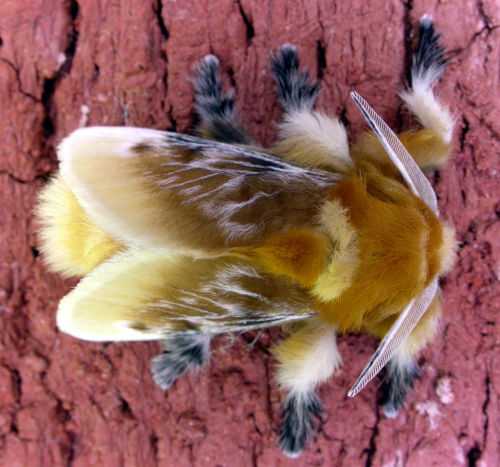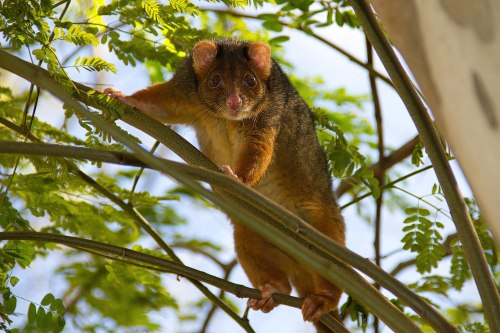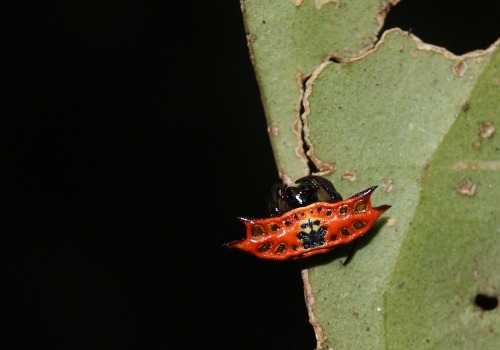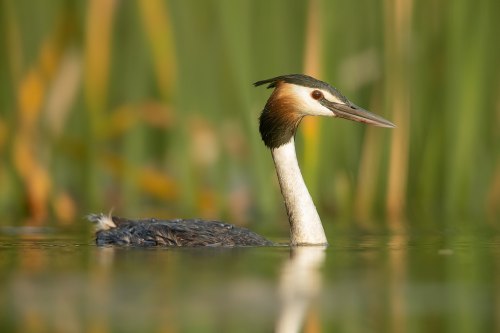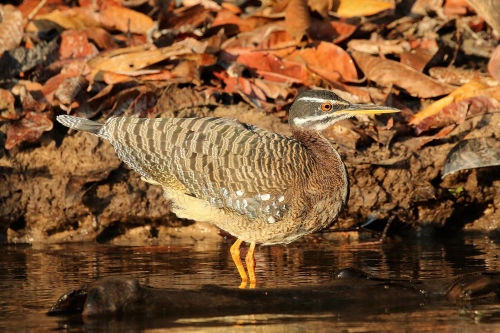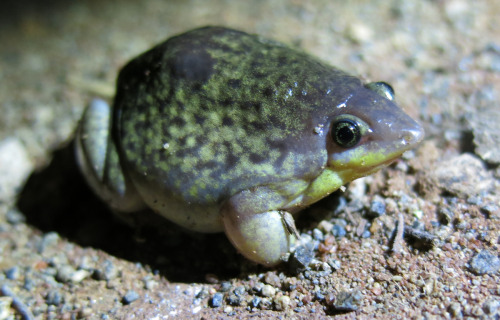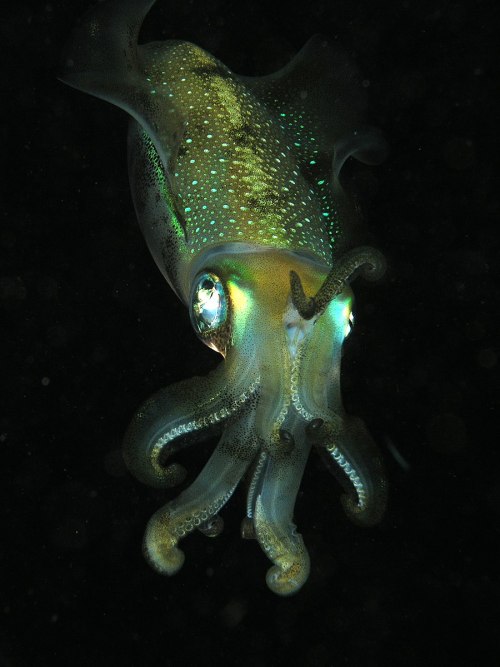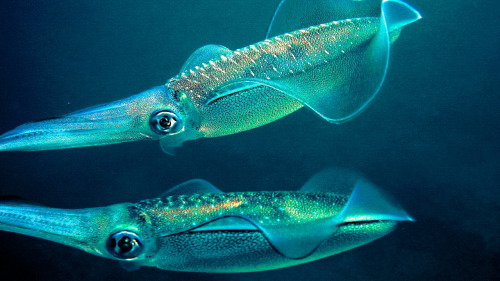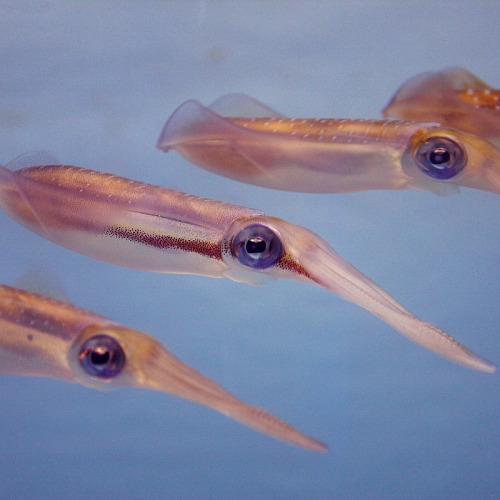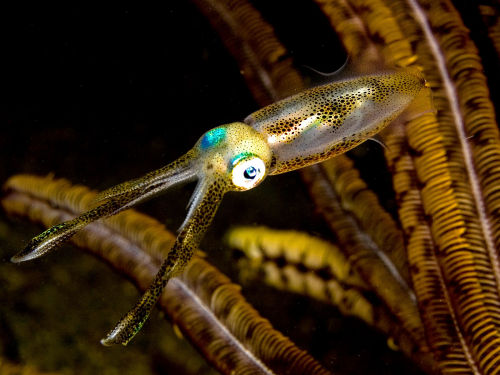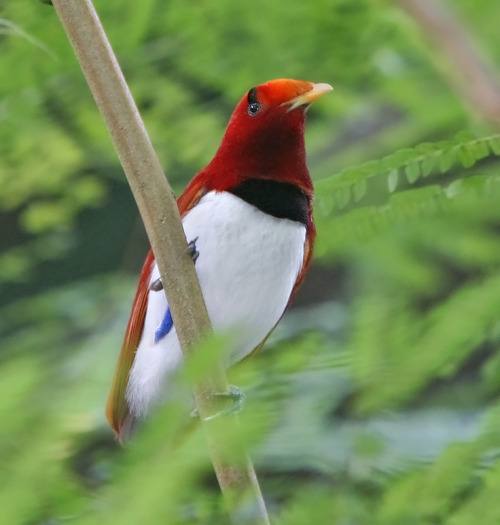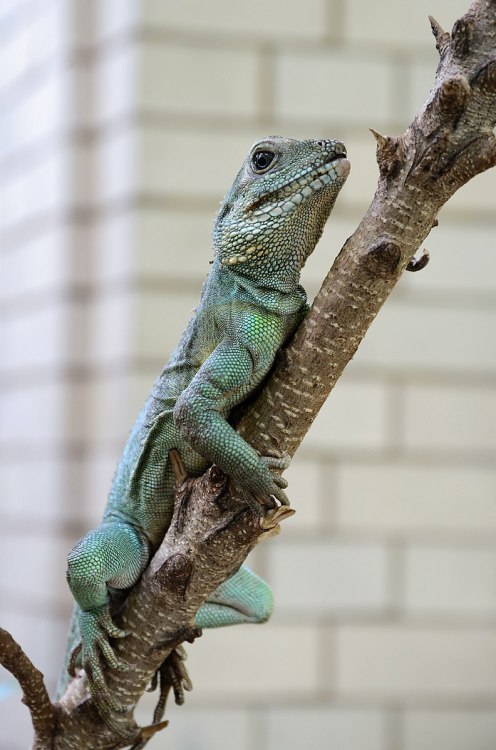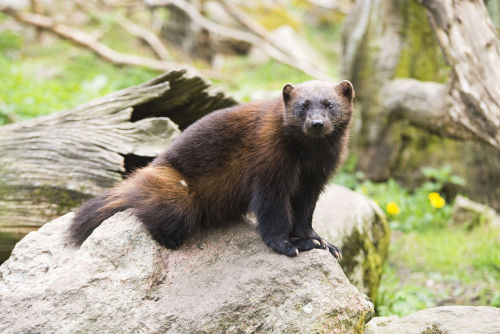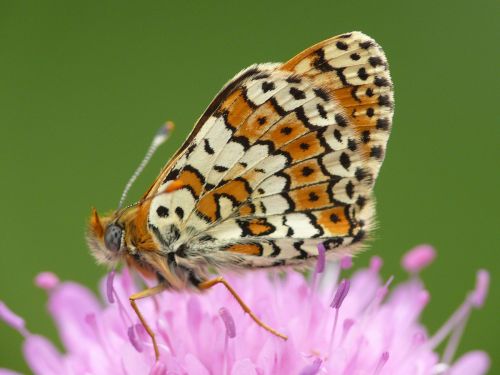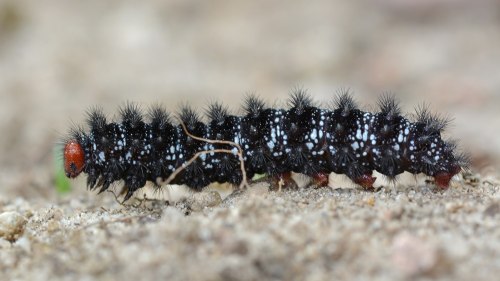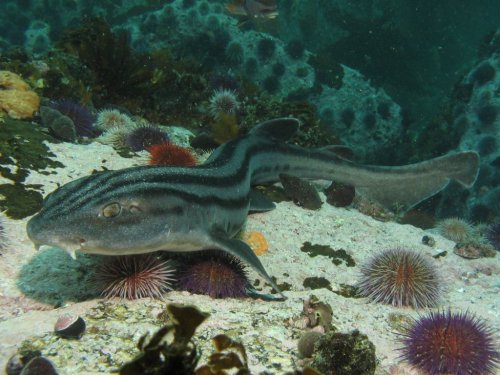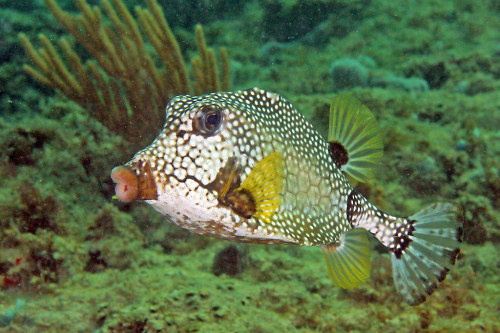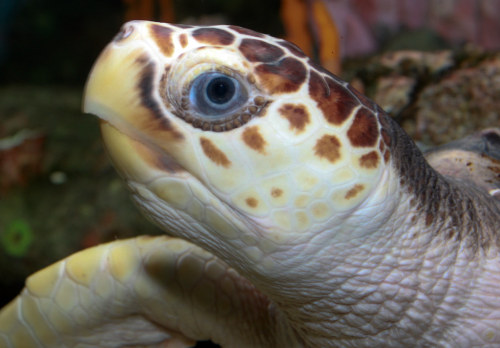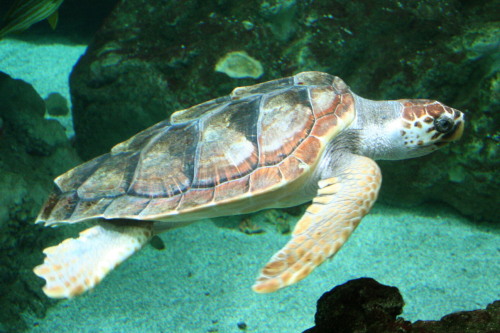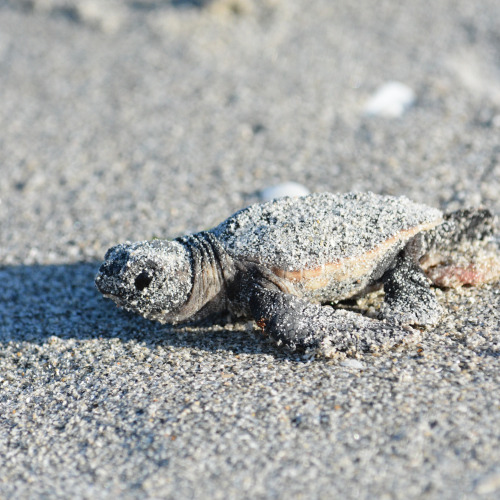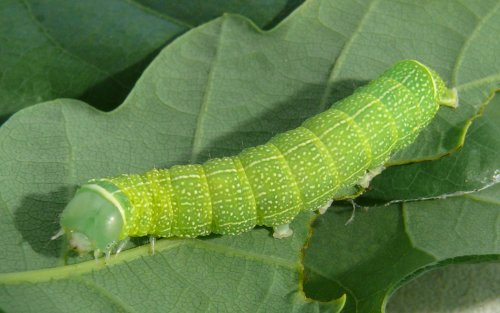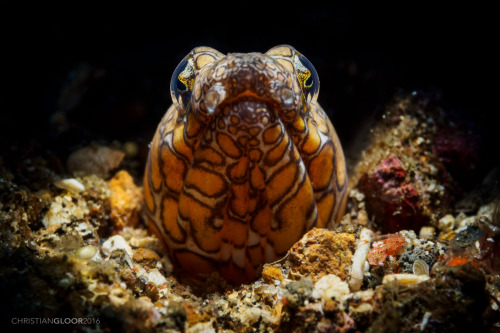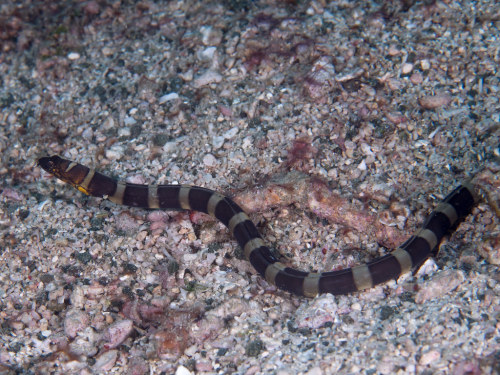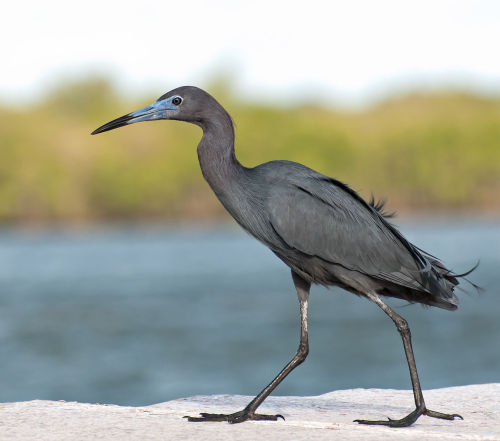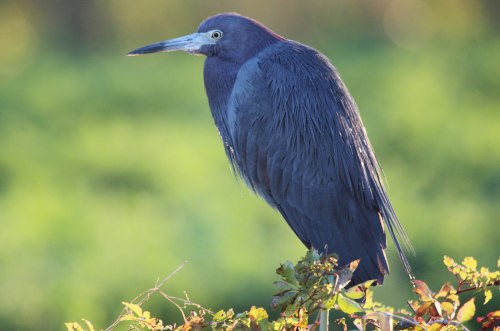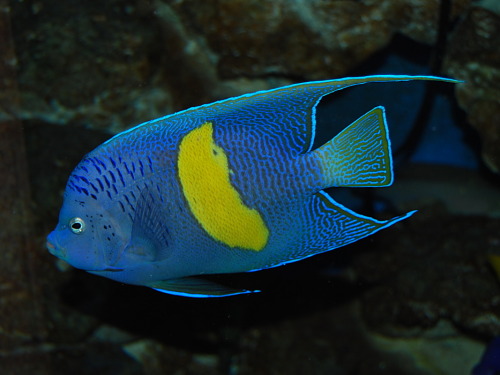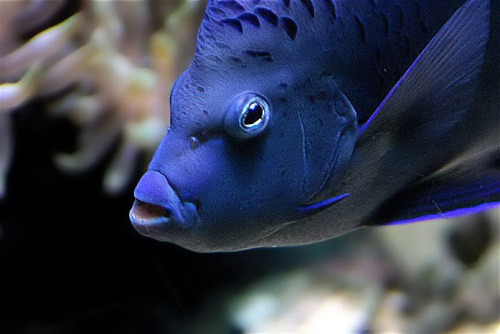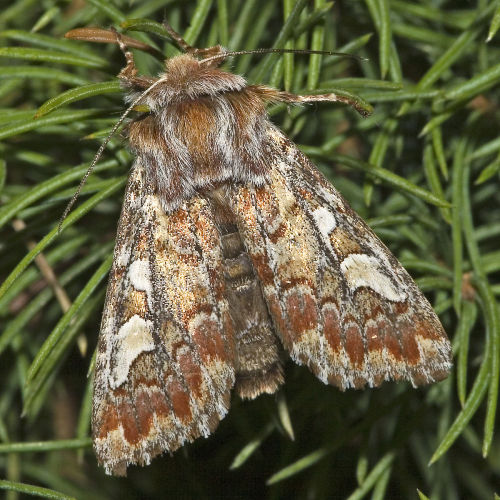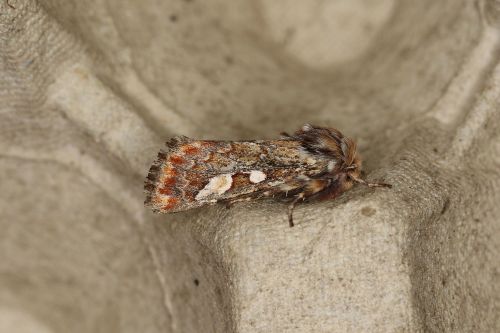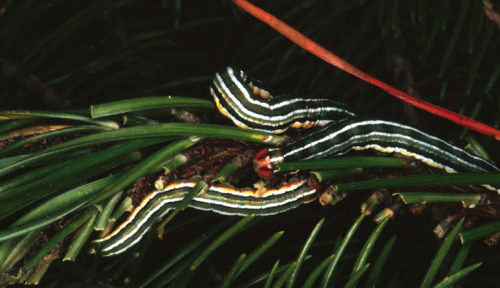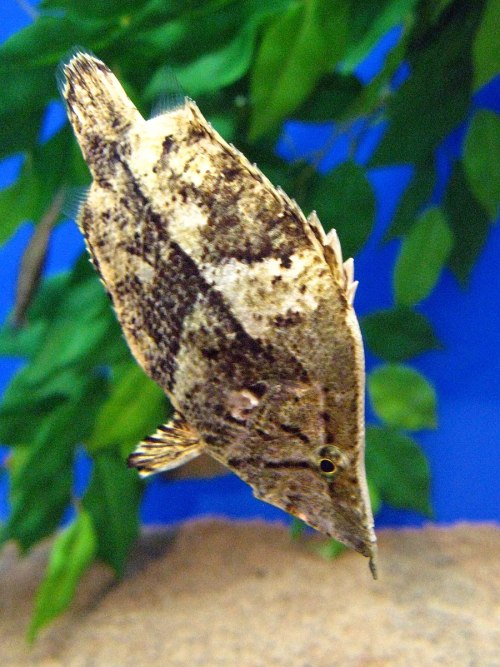#cool critters
Megalopyge opercularis
Megalopyge opercularis is a moth of the family Megalopygidae. The inch-long larva is generously coated in long, luxuriant hair-like setae, making it resemble a tiny Persian cat. The “fur” of the larva contains venomous spines that cause extremely painful reactions in human skin upon contact. The adult moth is covered in long fur in colors ranging from dull orange to lemon yellow, with hairy legs and fuzzy black feet. M. opercularis can be found on oak, elm, and wild plum, among others, as well as many garden plants such as roses and ivy. It is distributed throughout the eastern United States between extreme southeastern Virginia and Florida, the southern United States, Mexico, and parts of Central America. The caterpillar is regarded as a dangerous insect because of its venomous spines. Exposure to the caterpillar’s fur-like spines leads to an immediate skin irritation characterized by a “grid-like hemorrhagic papular eruption with severe radiating pain.” Victims describe the pain as similar to a broken bone or blunt-force trauma. The reactions are sometimes localized to the affected area, but are often very severe, radiating up a limb and causing burning, swelling, nausea, headache, abdominal distress, rashes, blisters, and sometimes chest pain, numbness, or difficulty breathing.
photo credits: Patrick Coin,Amizrachi,Lacy L. Hyche
Post link
Common ringtail possum (Pseudocheirus peregrinus)
The common ringtail possum is an Australian marsupial. It lives in a variety of habitats and eats a variety of leaves of both native and introduced plants, as well as flowers, fruits and sap. This possum also consumes a special type of faeces that is produced during the daytime when it is resting in a nest. This behaviour is called caecotrophy and is similar to that seen in rabbits. The common ringtail possum weighs between 550 and 1100 g and is approximately 30–35 cm long when grown. The common ringtail possum is nocturnal and well adapted to arboreal life. It relies on its prehensile tail and rarely descends to the ground. They communicate with soft, high-pitched, and twittering calls.
photo credits: Andrew Mercer,Glen Fergus
Post link
Jocotoco antpitta (Grallaria ridgelyi)
The jocotoco antpitta is an endangered antpitta, a bird from Ecuador and Peru.The jocotoco antpitta is a large (150–200 g) antpitta with a striking head pattern showing tufts of white plumes beneath the eyes. It has a song similar to the hooting of the rufous-banded owl. It inhabits only wet, mossy forest with ample Chusquea bamboo stands and silvery-leaved Cecropia trees. It is found at altitudes of 2,250 to 2,700 meters.The IUCN classifies it as endangered.
photo credits: Supreet Sahoo
Post link
Four-spined jewel spider (Gasteracantha quadrispinosa)
The four-spined jewel spider is a brightly coloured species of spider in the spiny orb-weaver genus Gasteracantha.It occurs in wet forests of Queensland, Australia, and New Guinea, where it builds vertical orb webs approximately 1.5 m across and hangs in the centre of the web to wait for prey. Female four-spined jewel spiders are distinctively shaped and coloured. Their abdomens are flat, oblong, and curved slightly forward, 5-6 mm wide, excluding spines. The corners of the abdomen are armed with short spines, the rear pair slightly longer than the pair in front.
photo credits: Danny S.
Post link
Great crested grebe (Podiceps cristatus)
The great crested grebe is a member of the grebe family of water birds noted for its elaborate mating display. The great crested grebe is the largest member of the grebe family found in the Old World, with some larger species residing in the Americas. They measure 46–51 cm long with a 59–73 cm wingspan and weigh 0.9 to 1.5 kg.It is an excellent swimmer and diver, and pursues its fish prey underwater. The adults are unmistakable in summer with head and neck decorations. The young are distinctive because their heads are striped black and white. The great crested grebe has an elaborate mating display. Like all grebes, it nests on the water’s edge, since its legs are set relatively far back and it is thus unable to walk very well. In a clutch of two or more hatchlings, male and female grebes will each identify their ‘favourites’, which they alone will care for and teach. Unusually, young grebes are capable of swimming and diving almost at hatching. The adults teach these skills to their young by carrying them on their back and diving, leaving the chicks to float on the surface; they then re-emerge a few feet away so that the chicks may swim back onto them. The great crested grebe feeds mainly on fish, but also small crustaceans, insects small frogs and newts.
photo credits: JJ Harrison,Bengt Nyman,Yerpo,Ken Billington
Post link
Sunbittern (Eurypyga helias)
The sunbittern is a bittern-like bird of tropical regions of the Americas, and the sole member of the family Eurypygidae and genus Eurypyga. It is found in Central and South America, and has three subspecies. The species is found in the humid Neotropical forests, generally with an open understorey and near rivers, streams, ponds or lagoons. They are cryptic birds that display their large wings, that exhibits a pattern that resemble eyes, when they feel threatened. The sunbittern consumes a wide range of animal prey. Insects form an important part of the diet, with cockroaches, dragonfly larvae, files, katydids, water beetles and moths being taken. Other invertebrate prey includes crabs, spiders, shrimps and earthworms. They will also take vertebrate prey including fish, tadpoles, toads and frogs, eels and lizards. Sunbitterns are one of 12 species of birds in five families that have been described as fishing using baits or lures to attract prey to within striking distance. This type of behaviour falls within the common definition of tool use. In sunbitterns this behaviour has only been observed in captive birds so far.
photo credits: Sharp Photography,Stavenn,Snowmanradio
Post link
Marbled snout-burrower (Hemisus marmoratus)
The marbled snout-burrower is a species of frog in the family Hemisotidae. It is found in sub-Saharan Africa. Its natural habitats are subtropical or tropical dry forest, moist lowland forest, savanna, shrubland, grassland, swamps, freshwater lakes, freshwater marshes, arable land, plantations, seasonally flooded agricultural land, and canals and ditches.
photo credits: Ryanvanhuyssteen
Post link
Bigfin reef squid (Sepioteuthis lessoniana)
The bigfin reef squid is a commercially important species of loliginid squid. Bigfin reef squids are characterised by a large oval fin that extends throughout the margins of its mantle, giving them a superficial similarity to cuttlefish. They are small to medium-sized squids, averaging 3.8 to 33 cm in length. They exhibit elaborate mating displays and usually spawn in May, but it can vary by location. The paralarvae resemble miniature adults and are remarkable for already having the capability to change body colouration upon hatching. Bigfin reef squids have the fastest recorded growth rates of any large marine invertebrate, reaching 600 g in only four months. They are a short-lived species, with a maximum recorded lifespan of 315 days. The diet of bigfin reef squids comprises mainly crustaceans and small fish. They are found in the temperate and tropical waters of the Pacific and Indian Oceans, and have recently been introduced into the Mediterranean as a Lessepsian migrant. They are commonly found near the shoreline, near rocks, and coral reefs. They are fished in vast quantities for human food in Asia. Because of their rapid growth rate, short life span, and tolerance to handling and captivity, bigfin reef squids are regarded as one of the most promising species for mariculture. They are also a valuable source of giant axons for medical research.
photo credits: Nhobgood,Divervincent,wiki,Nhobgood
Post link
King bird-of-paradise (Cicinnurus regius)
The king bird-of-paradise is a passerine bird of the Paradisaeidae (Bird-of-paradise) family. It is the sole member of the genus Cicinnurus.The king bird-of-paradise is distributed throughout lowland forests of New Guinea and nearby islands. The diet consists mainly of fruits and arthropods. An extraordinary courtship display is performed by the male with a series of tail swinging, fluffing of the white abdominal feathers that makes the bird look like a cottonball, and acrobatic movements of their elongated tail wires.
photo credits: Doug Janson
Post link
Chinese water dragon (Physignathus cocincinus)
The Chinese water dragon is a species of agamid lizard native to China and mainland Southeast Asia. Chinese water dragons can grow up to 1 m in total length, including tail, and can live from 10 to 15 years. Coloration ranges from dark to light green, or sometimes purple with an orange stomach. Like many other reptiles the Chinese water dragon possesses a small, iridescent, photosensitive spot between their eyes referred to as the pineal eye (or parietal eye, or colloquially as the third eye) that is thought to help thermoregulate their bodies by sensing differences in light to assist with basking and seeking shelter after sunset. Since it recognizes differences in light, the parietal eye can also help the lizard avoid predation from birds and other aerial threats, and can awaken from deep sleep from even slight changes in light from overhead.Native to the lowland and highland forests of southern China and southeastern Asia (Thailand, Vietnam, Laos, Cambodia and Burma), Chinese water dragons are most commonly found along the banks of freshwater lakes and streams. They are active during the day (diurnal), and spend most of their time in the trees or plants (arboreal). If threatened, the dragon will drop from the trees into the water and either swim to safety or remain submerged for up to 90 minutes. Though they will also eat vegetation, the diet of the water dragon consists mainly of insects, supplemented with an occasional small fish, mammal or reptile.
photo credits: Marcel Burkhard,Rushenb,Alvesgaspar
Post link
Wolverine (Gulo gulo)
The wolverine is the largest land-dwelling species of the family Mustelidae. It is a stocky and muscular carnivore, more closely resembling a small bear than other mustelids. A solitary animal, it has a reputation for ferocity and strength out of proportion to its size, with the documented ability to kill prey many times larger than itself. The wolverine is found primarily in remote reaches of the Northern boreal forests and subarctic and alpine tundra of the Northern Hemisphere, with the greatest numbers in Northern Canada, the American state of Alaska, the mainland Nordic countries of Europe, and throughout western Russia and Siberia. Its population has steadily declined since the 19th century owing to trapping, range reduction and habitat fragmentation. The wolverine is now essentially absent from the southern end of its European range. Though its legs are short, its large, five-toed paws with crampon-like claws and plantigrade posture enable them to climb up and over steep cliffs, trees and snow-covered peaks with relative ease.
photo credits: Jonathan Othén
Post link
Glanville fritillary (Melitaea cinxia)
The Glanville fritillary is a butterfly of the family Nymphalidae. These butterflies live in almost all of Europe, especially Finland, and in parts of northwest Africa. It has been discovered that this butterfly only mates one time in June or July and lays its eggs. It does not provide any protection to these eggs or care for the offspring. As adults, the Glanville fritillaries are short-lived; they spend most of their lives as caterpillars. As caterpillars, Glanville fritillaries enter a stage of diapause, which is a period of suspended development, during the winter time. The spiked speedwell and ribwort plantain are the Glanville fritillary’s preferred plants to lay eggs and to eat as larvae. Female butterflies will show a preference for one plant species over the other when deciding where to lay their eggs, but the caterpillars have no preference once they hatch. After entering the adult phase the fritillaries feed on nectar of the spiked speedwell and ribwort plantain, among others. This species of butterfly is at risk of population decline because it is not a migratory species.
photo credits: Harald Süpfle,Sven Damerow
Post link



Lion-tailed macaque (Macaca silenus)
The lion-tailed macaque is an Old World monkey endemic to the Western Ghats of South India. The lion-tailed macaque is a rainforest dweller; it is diurnal, meaning it is active exclusively in daylight hours. It is a good climber and spends a majority of its life in the upper canopy of tropical moist evergreen forests. Unlike other macaques, it typically avoids humans when possible. Lion-tailed macaque behaviour is characterized by typical patterns such as arboreal living, selectively feeding on a large variety of fruit trees, large interindividual spaces while foraging, and time budgets with high proportion of time devoted to exploration and feeding.
photo credits: Wer-Al Zwowe,Nihaljabinedk,Kalyanvarma


Anthaxia candens
Anthaxia candens is a jewel beetle. The biggest of its order in Europe.
photo credits:Jürgen Mangelsdorf,Udo Schmidt



Chestnut-bellied sandgrouse (Pterocles exustus)
The chestnut-bellied sandgrouse is a species of sandgrouse. It is a sedentary and nomadic species that ranges from northern and central Africa and further east towards western and southern Asia. The chestnut-bellied sandgrouse is sexually dimorphic in plumage colouration. The chestnut-bellied sandgrouse is a bird of barren, semi-deserts. It is heavily reliant on water, despite living in hot, arid climates and is known to travel up to 80 km in a day to search for water. Chestnut-bellied sandgrouse are selective feeders which primarily subsist on seeds, often preferring to consume small seeds in large amounts.
photo credits: rainbirder,Arun Thangaraj,Seshadri.K.S
Pyjama shark (Poroderma africanum)
The pyjama shark is a species of catshark, and part of the family Scyliorhinidae, endemic to the coastal waters of South Africa. This abundant, bottom-dwelling species can be found from the intertidal zone to a depth of around 100 m, particularly over rocky reefs and kelp beds. With a series of thick, parallel, dark stripes running along its stout body, the pyjama shark has an unmistakable appearance. It can grow up to a length of 1.1 m long. The pyjama shark is primarily nocturnal, spending most of the day lying motionless and hidden in a cave or crevice or among vegetation. It often forms groups, particularly during summer. This species is an opportunistic predator that feeds on a wide variety of fishes and invertebrates; it favors cephalopods and frequents the spawning grounds of the chokka squid. When threatened, it curls into a circle with its tail covering its head. Reproduction is oviparous, with females laying rectangular, dark brown egg cases two at a time year-round.
photo credits: Guido Zsilavecz,Illustrations of the Zoology of South Africa
Post link
Smooth trunkfish (Lactophrys triqueter)
The smooth trunkfish is a species of boxfish found on and near reefs in the Caribbean Sea, Gulf of Mexico and subtropical parts of the western Atlantic Ocean. The smooth trunkfish has an angular body sheathed in plate-like scales, growing to a maximum length of 47 cm, though 20 cm is a more normal size. The smooth trunkfish is found down to a depth of about 50 m on coral reefs and over sandy seabeds. The smooth trunkfish is normally solitary but sometimes moves around in small groups. It uses its protuberant lips to expel a jet of water which disturbs the sandy seabed and reveals any shallowly buried benthic invertebrates. It feeds on small molluscs, polychaete worms, acorn worms, peanut worms, small crustaceans, sponges and tunicates.
photo credits: Kevin Bryant
Post link
Loggerhead sea turtle (Caretta caretta)
The loggerhead sea turtle is a species of oceanic turtle distributed throughout the world. It is a marine reptile, belonging to the family Cheloniidae. The average loggerhead measures around 90 cm in carapace length when fully grown. The adult loggerhead sea turtle weighs approximately 135 kg, with the largest specimens weighing in at more than 450 kg. The skin ranges from yellow to brown in color, and the shell is typically reddish brown. The loggerhead sea turtle is found in the Atlantic, Pacific, and Indian Oceans, as well as the Mediterranean Sea. It spends most of its life in saltwater and estuarine habitats, with females briefly coming ashore to lay eggs. The loggerhead sea turtle is omnivorous, feeding mainly on bottom-dwelling invertebrates. Its large and powerful jaws serve as an effective tool for dismantling its prey. Young loggerheads are exploited by numerous predators; the eggs are especially vulnerable to terrestrial organisms. Once the turtles reach adulthood, their formidable size limits predation to large marine animals, such as sharks. The loggerhead sea turtle is considered a vulnerable species by the International Union for the Conservation of Nature. In total, 9 distinct population segments are under the protection of the Endangered Species Act of 1973, with 4 population segments classified as “threatened” and 5 classified as “endangered”.
photo credits: Brian Gratwicke,Brian Gratwicke,Strobilomyces,Jean-Lou Justine
Post link
Common Quaker (Orthosia cerasi)
The common Quaker is a moth of the family Noctuidae. It is distributed throughout Europe and is also found in Turkey, Israel, Transcaucasia, Russia and eastern Siberia. This is a variable species, the ground colour of the forewings ranging from greyish to orangey brown, sometimes with a broad dark band. The most distinctive features are two large stigmata, each edged by a narrow pale line, with a similarly coloured subterminal line.The wingspan is 34–40 mm. This moth flies at night in March and April and is attracted to light and sugar. The larva feeds on various trees and shrubs including apple, buckthorn, elm, oak, pear, poplar and willow as well as various Prunus species. The species overwinters as a pupa.
photo credits: Olaf Leillinger,Harald Süpfle
Post link
Napoleon snake eel(Ophichthus bonaparti)
The Napoleon snake eel is an eel in the family Ophichthidae (worm/snake eels). It is a marine, tropical eel which is known from the Indo-Pacific, including Durban, South Africa, Mauritius, Indonesia, Japan, Australia, and the Penghu Islands. It is known to dwell at a depth of 20 metres, and inhabits lagoons and reefs; it forms solitary burrows in sand sediments. Males can reach a maximum total length of 75 cm.
photo credits: Christian Gloor,divemecressi,Rickard Zerpe
Post link
Little blue heron (Egretta caerulea)
The little blue heron is a small heron belonging to the family Ardeidae. These herons breed in the Gulf states of the United States, through Central America and the Caribbean south to Peru and Uruguay. It is a resident breeder in most of its range, but some northern breeders migrate to the southeastern US or beyond in winter. This species is about 64–76 cm long, with a 102 cm wingspan, and weighs 325 g.These herons prefer freshwater swamps and lagoons in the South, while on islands in the North they inhabit coastal thickets. They breed in sub-tropical and tropical swamps with mangrove vegetation, wetlands (bogs, fens, peatlands, etc.) and marine intertidal salt marshes. It eats fish, frogs, crustaceans, small rodents and insects.
photo credits: Dario Sanches,Sandhillcrane
Post link
Halfmoon angelfish (Pomacanthus maculosus)
The halfmoon angelfish is a marine angelfish. The species lives mainly in coral and rocky areas, in shallow to moderate depths, though it is more often in silty reef areas than in rich coral growth. This angelfish grows to a size of 50 cm in length. As with other large angelfish in genus Pomacanthus, juveniles and sub-adults are differently marked and colored than adults. Small halfmoon angelfish are alternately blue, white, and black banded. Pomacanthus maculosus is distributed throughout the Persian Gulf, the northwestern Indian Ocean, and the Red Sea south to 19°S. This species has a diet typical of angelfishes. Its main food is sponges. It also eats small anemones, algae, tubeworms, and shrimp.
photo credits: Heinz Albers,Petra Karstedt,Exaybachay
Post link
Emperor scorpion (Pandinus imperator)
The emperor scorpion is a species of scorpion native to rainforests and savannas in West Africa. It is one of the largest scorpions in the world, with adults averaging about 20 centimetres in length and a weight of 30 g, and lives for 6–8 years. Its body is black, but like other scorpions it glows pastel green or blue under ultraviolet light. It is a popular species in the pet trade, and is protected by CITES. Scorpion stings can be categorized as mild (similar to a bee sting) to severe to humans depending on the species. Most people are not affected by the emperor scorpion’s sting, though some people may be allergic to scorpion stings in general. Sensory hairs cover the pincers and tail, enabling the emperor scorpion to detect prey through vibrations in the air and ground. They are known for their docile behavior and almost harmless sting; they do not use their sting to defend themselves when they are adults, however, they may use it in their adolescent stages. The emperor scorpion is an African rainforest species, but also present in savanna. This species inhabits both tropical forest and open savannas. The emperor scorpion burrows beneath the soil and hides beneath rocks and debris, and also often burrows in termite mounds. In the wild, emperor scorpions primarily consume insects and other terrestrial invertebrates, although termites constitute a large portion of their diet. Larger vertebrates, such as rodents and lizards, are occasionally eaten.
photo credits: Rosa Pineda,Mike Baird
Post link
Hildebrandt’s starling (Lamprotornis hildebrandti)
Hildebrandt’s starling is a species of starling in the family Sturnidae. Hildebrandt’s starling is found in Kenya and Tanzania, where it occupies open country between 500 to 2,200 m. Its habitat is open woodland and open thornbrush country. Hildebrandt’s starling is 18 cm in length and weighs 50 to 69 g. The diet of Hildebrandt’s starling is a combination of insects and fruit, with insects apparently being the more important constituent. It usually feeds on the ground, in pairs and small flocks, and will readily follow large mammals and catch prey flushed by their movement. It also joins mixed flocks of other starlings.
photo credits: Noel Feans
Post link
Pine beauty (Panolis flammea)
The pine beauty is a moth of the family Noctuidae. It is a common species in Europe. The distribution area extends from the west of Catalonia over southern France, central Italy, central Europe to western Siberia, the Caucasus and Asia Minor. The wingspan is 32–40 mm. This moth flies at night from March to May and is attracted to light and sallow blossom. Larva are bright green with the lines broadly white edged with deep green; spiracular line edged below with yellow. It feeds on the needles of Pinus sylvestris and other pines, but sometimes on other trees, and can be a serious pest in forests. The species overwinters as a pupa.
photo credits: Olei,Donald Hobern,Hannes Lemme
Post link
Amazon leaffish (Monocirrhus polyacanthus)
The Amazon leaffish is a species of fish belonging to the family Polycentridae. It is found in the Amazon basin in Bolivia, Brazil, Colombia, Peru and Venezuela, where it inhabits edges of rivers and lakes, and streams. It is generally a low-density species that lives in slow-moving or essentially stagnant waters in areas with plant debris. The Amazon leaffish reaches a maximum standard length of 8 cm, and a total length of 10 cm. As suggested by its common name, it closely resembles a dead leaf. The flattened body and filament at the tip of the lower jaw (resembling a stalk) further enhances its similarity to a leaf. The Amazon leaffish is highly predatory, feeding on small invertebrates (aquatic insects like mayfly nymphs and crustaceans like shrimp) and fish (especially Characids and Lebiasinids). Small Amazon leaffish mostly feed on invertebrates, while larger individuals mainly feed on fish. It swims very slowly in a head-down position, resembling a dead leaf floating in the current, to approach its prey. When near, it protracts its mouth to form a tube. The prey is rapidly sucked in, usually head-first. Prey in its stomach is often folded, allowing the leaffish to fit relatively large items
photo credits: KENPEI
Post link

